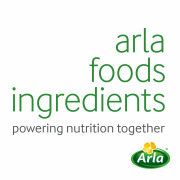News
Whey protein on the rise across food categories
13 Nov 2018Whey protein remains the most popular protein ingredient for athletes by far, but numerous whey protein ingredients have emerged over the past few years, in applications that take it well beyond sports nutrition.

Whey protein has been used as an ingredient for decades, particularly in sports shakes and bars, to help with muscle recovery after exercise. More recently, however, food manufacturers have been revisiting its many functions. While the mainstreaming of the sports nutrition sector undoubtedly has added to its appeal, more specialist whey protein ingredients are appearing in foods intended for the general public, in baked goods in particular, and they are benefiting from widespread consumer interest in added protein.
Suppliers include FrieslandCampina, Agropur Ingredients and Arla Foods Ingredients, all of which have recently introduced new whey protein ingredients.
Agropur Ingredients, for example, has launched a line of extruded whey protein ‘pods’, which are 70% protein crisps made with whey protein concentrate and whey protein isolate. The ingredient can add texture and protein to granola or baked goods as an inclusion or as a topping, and can be used either as a plain, neutral-tasting crisp, or enrobed in chocolate or other flavoured coatings.
Usually, whey protein is a by-product of the cheese making process, but FrieslandCampina Ingredients has introduced a premium native whey protein derived directly from raw grass-fed dairy milk. It says this story can be passed on to the consumer to differentiate protein-rich foods and drinks, particularly for those looking for more natural, minimally processed ingredients.
Meanwhile, Arla Foods Ingredients aims to tap into the continuing appeal of protein-enriched dairy products, from ice cream and yoghurt to beverages, quark and skyr. In addition, it has introduced a whey protein ingredient that can soften high protein bars and improve their texture. For protein bar manufacturers, this means a longer shelf life and less wastage, while for consumers, better texture improves palatability.
According to Research and Markets, the protein ingredients market is expected to increase at a compound annual growth rate of 6% between 2017 and 2022 to reach $58.49 billion. Despite the popularity of plant-based proteins, whey and other animal-derived proteins continue to lead the category, largely because of their more complete nutritional profile.
As many food manufacturers are seeking out the next novel protein ingredient – whether from plants, insects or algae – well established proteins like whey may be worth exploring too, for their taste, functionality, clean label, nutrition and availability.
Related news

PepsiCo feels the heat as drinks giant cools its climate targets
3 Jul 2025
PepsiCo has become the latest global food and beverage manufacturer to attract criticism for changing a number of its environmental goals.
Read more
Coca-Cola accused of ‘sportswashing’ amid FIFA sponsorship storm
30 Jun 2025
Doctors and health campaigners are calling for football's governing body, FIFA, to drop Coca-Cola as a 2025 Club World Cup sponsor, accusing the soda giant of “sportswashing”.
Read more
World Food Safety Day shines a spotlight on science
19 Jun 2025
On 7 June, the World Health Organization (WHO) held its annual World Food Safety Day, highlighting the role scientific research and innovation play in supporting consumers’ health.
Read more
Compostable packaging claims rubbished by regulator
9 Jun 2025
Compostable coffee capsule ads from brands including Dualit and Lavazza Coffee have been banned after the UK’s advertising watchdog deemed them to be "misleading".
Read more
How will US ban on artificial dyes impact global F&B brands?
20 May 2025
As the US prepares to ban synthetic colourings from the food and beverage (F&B) industry, what will the impact be for brands in Europe and beyond?
Read more
Grocery retail shows cautious optimism and stabilisation
15 May 2025
Health and functionality, personalisation, convenience, advancing technologies, and sustainability dominate the grocery retail landscape and the shoppers of the future.
Read more
Bisphenol A packaging ban brings challenges and concerns
14 May 2025
A ban on bisphenol A (BPA), as well as other bisphenols used in so-called “food contact materials” (FCMs), came into force across the EU in January. What happens now?
Read more
US snack purchases fall as tariffs and inflation drive indulgence cutbacks
9 May 2025
US consumers are reducing their snack purchases as (fears of) tariffs and sustained inflation drive up food costs and force households to prioritise spending.
Read more
How can brands navigate US tariffs on sugar alternatives?
7 May 2025
US tariffs on monk fruit and stevia may push food and beverage brands to rethink their sugar reduction strategies.
Read more
UK cools trade heat as it suspends tariffs on chilli peppers
6 May 2025
The UK Government has promised food businesses cheaper ingredients in time for the summer by suspending the UK global tariff (UKGT).
Read more

